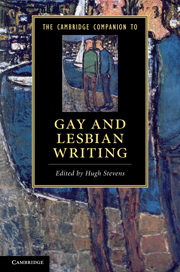Homosexuality and literature: an introduction
Published online by Cambridge University Press: 28 January 2011
Summary
“'I wish we were labelled,' said Rickie. He wished that all the confidence and mutual knowledge that is born in such a place as Cambridge could be organized. People went down into the world saying, 'We know and like each other; we shan't forget.' But they did forget, for man is so made that he cannot remember long without a symbol; he wished there was a society, a kind of friendship office, where the marriage of true minds could be registered.” E. M. Forster, The Longest Journey (1907) / In many parts of Europe - though not in most states of America - the wish that Forster's Rickie made just over a century ago has been granted. Since the Second World War, we have gradually entered an era of greater tolerance. Homosexuality has been decriminalized in most of the world's democracies, and since the 1990s same-sex marriages and partnerships have begun to be recognized in an ever-growing number of countries. This greater tolerance has led to changes in the ways that same-sex relationships and same-sex desire are recognized, given 'symbols'. Rickie thinks mournfully that 'a few verses of poetry is all that survives of David and Jonathan'. Today, however, Davids and Jonathans, Ruths and Naomis, are marrying their true minds in various kinds of friendship offices. Followers of gay and lesbian trends are wondering how same-sex marriages, or 'civil unions', will be represented on celluloid and between book covers. And how will same-sex couples negotiate the challenges of divorce?
- Type
- Chapter
- Information
- The Cambridge Companion to Gay and Lesbian Writing , pp. 1 - 14Publisher: Cambridge University PressPrint publication year: 2010

